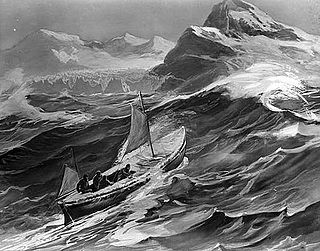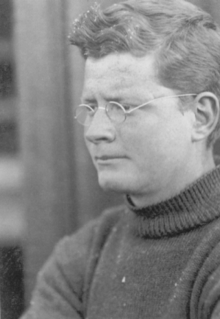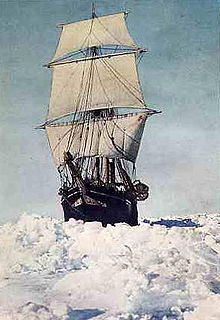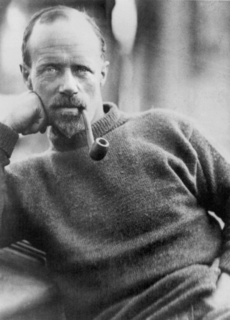 W
WThe Imperial Trans-Antarctic expedition of 1914–1917 is considered to be the last major expedition of the Heroic Age of Antarctic Exploration. Conceived by Sir Ernest Shackleton, the expedition was an attempt to make the first land crossing of the Antarctic continent. After Amundsen's South Pole expedition in 1911, this crossing remained, in Shackleton's words, the "one great main object of Antarctic journeyings". The expedition failed to accomplish this objective, but became recognized instead as an epic feat of endurance.
 W
WPerce Blackborow was a Welsh sailor and a stowaway on Ernest Shackleton's ill-fated Imperial Trans-Antarctic Expedition of 1914–1917.
 W
WSir James Key Caird, 1st Baronet was a Scottish jute baron and mathematician. He was one of Dundee's most successful entrepreneurs, who used the latest technology in his Ashton and Craigie Mills.
 W
WCave Cove is a small cove located in King Haakon Bay, South Georgia. It is best known for its connection to Ernest Shackleton's Imperial Trans-Antarctic Expedition. It was where the James Caird landed on 10 May 1916, after its tumultuous voyage from Elephant Island. The voyage is commemorated by a small plaque in the rock.
 W
WAlfred Cheetham was a member of several Antarctic expeditions. He served as third officer for both the Nimrod expedition and Imperial Trans-Antarctic expedition.
 W
WThomas Crean was an Irish seaman and Antarctic explorer who was awarded the Albert Medal for Lifesaving.
 W
WElephant Island is an ice-covered, mountainous island off the coast of Antarctica in the outer reaches of the South Shetland Islands, in the Southern Ocean. The island is situated 245 kilometres north-northeast of the tip of the Antarctic Peninsula, 1,253 kilometres west-southwest of South Georgia, 935 kilometres south of the Falkland Islands, and 885 kilometres southeast of Cape Horn. It is within the Antarctic claims of Argentina, Chile and the United Kingdom.
 W
WEndurance was the three-masted barquentine in which Sir Ernest Shackleton and a crew of 27 men and one cat sailed for the Antarctic on the 1914–1917 Imperial Trans-Antarctic Expedition. She was launched in 1912 from Sandefjord in Norway; three years later, she was crushed by pack ice and sank in the Weddell Sea off Antarctica. All of her crew survived.
 W
WEndurance: Shackleton's Incredible Voyage, is a 1959 book written by Alfred Lansing, about the failure of the Imperial Trans-Antarctic Expedition led by Sir Ernest Shackleton, in its attempt to cross the Antarctic continent in 1914.
 W
WFortuna Glacier is a tidewater glacier at the mouth of Cumberland Bay on the island of South Georgia. It flows in a northeast direction to its terminus just west of Cape Best, with an eastern distributary almost reaching the west side of Fortuna Bay, on the north coast of South Georgia. It was named in about 1912, presumably after the whale catcher Fortuna, and is notable for two major events in the 20th Century.
 W
WCharles Green, also known as Charlie Green, was a British ship's cook, who took part in Sir Ernest Shackleton's Imperial Trans-Antarctic Expedition as the cook for the Weddell sea party on board the Endurance. The son of a master baker, Charles learnt to bake, but ran away at the age of 22 to join the Merchant Navy. At an unknown time in his life, Green had an accident which resulted in the loss of one of his testicles. This resulted in Green having a somewhat squeaky and high-pitched voice, which was the source of jokes amongst his fellow crew aboard the Endurance. Whilst in Buenos Aires on board the Andes in October 1914, he heard word that Shackleton had fired the expedition's cook, for drunkenness, and was subsequently hired.
 W
WLionel Greenstreet (1889–1979) was the first officer of the Endurance and a member of the Imperial Trans-Antarctic Expedition of 1914–1917, for which he was awarded the Polar Medal. When he died on 13 January 1979, he was the last survivor of the Weddell Sea party within the expedition.
 W
WHuberht Taylor Hudson, commonly known as Hubert Hudson instead of by his actual first name, was a navigating officer in the British Royal Navy, who took part in Ernest Shackleton's Imperial Trans-Antarctic Expedition to Antarctica.
 W
WJames Francis "Frank" Hurley was an Australian photographer and adventurer. He participated in a number of expeditions to Antarctica and served as an official photographer with Australian forces during both world wars.
 W
WLeonard Duncan Albert Hussey, OBE was an English meteorologist, archaeologist, explorer, medical doctor and member of Ernest Shackleton's Imperial Trans-Antarctic and Shackleton–Rowett Expeditions. During the latter, he was with Shackleton at his death, and transported the body part-way back to England.
 W
WReginald William James, FRS was a student, researcher, and teacher of physics in England and South Africa. He is best known for his service in the Imperial Trans-Antarctic Expedition of 1914–1916, for which he was awarded the Silver Polar Medal.
 W
WErnest Edward Mills Joyce AM was a Royal Naval seaman and explorer who participated in four Antarctic expeditions during the Heroic Age of Antarctic Exploration, in the early 20th century. He served under both Robert Falcon Scott and Ernest Shackleton. As a member of the Ross Sea party in Shackleton's Imperial Trans-Antarctic Expedition, Joyce earned an Albert Medal for his actions in bringing the stricken party to safety, after a traumatic journey on the Great Ice Barrier. He was awarded the Polar Medal with four bars, one of only two men to be so honoured, the other being his contemporary, Frank Wild.
 W
WKing Haakon Bay, or King Haakon Sound, is an inlet on the southern coast of the island of South Georgia. The inlet is approximately eight miles (13 km) long and two point five miles (4 km) wide. The inlet was named for King Haakon VII of Norway by Carl Anton Larsen, founder of Grytviken. Queen Maud Bay, named for his queen, is nearby.
 W
WOle Aanderud Larsen was a ship designer and businessman from Norway.
 W
WAeneas Lionel Acton Mackintosh was a British Merchant Navy officer and Antarctic explorer, who commanded the Ross Sea party as part of Sir Ernest Shackleton's Imperial Trans-Antarctic Expedition, 1914–1917. The Ross Sea party's mission was to support Shackleton's proposed transcontinental march by laying supply depots along the latter stages of the march's intended route. In the face of persistent setbacks and practical difficulties, Mackintosh's party fulfilled its task, although he and two others died in the course of their duties.
 W
WAlexander Hepburne Macklin was a British physician who served as one of the two surgeons on Sir Ernest Shackleton's Imperial Trans-Antarctic Expedition of 1914–1917. In 1921–1922, he joined the Shackleton–Rowett Expedition aboard the Quest.
 W
WGeorge Edward Marston was an English artist who twice accompanied Sir Ernest Shackleton on expeditions to Antarctic, first from 1907–09 on the Nimrod expedition, and then later from 1914–17 on the Imperial Trans-Antarctic Expedition, which ended with the crew being marooned on Elephant Island.
 W
WTimothy 'Tim' McCarthy was an Irish able seaman (AB). He is best known for his service in the Imperial Trans-Antarctic Expedition of 1914–1916, for which he was awarded the Bronze Polar Medal.
 W
WMrs Chippy was a male ship's cat who accompanied Sir Ernest Shackleton's Imperial Trans-Antarctic Expedition of 1914–1917.
 W
WMajor Thomas Hans Orde-Lees, OBE, AFC was a member of Sir Ernest Shackleton's Imperial Trans-Antarctic Expedition of 1914–1917, a pioneer in the field of parachuting, and was one of the first non-Japanese-born men known to have climbed Mount Fuji during the winter.
 W
WLuis Antonio Pardo Villalón was a Chilean Navy officer who, in August 1916, commanded the steam tug Yelcho to rescue the 22 stranded crewmen of Sir Ernest Shackleton's ship, Endurance, part of the Imperial Trans-Antarctic Expedition. The crewmen were stranded on Elephant Island, an ice-covered mountainous island off the coast of Antarctica in the outer reaches of the South Shetland Islands, in the Southern Ocean.
 W
WPeggotty Bluff or Peggotty Camp, is a bluff on the north side and near the head of King Haakon Bay, South Georgia.
 W
WRampart Berg was an iceberg discovered by the Imperial Trans-Antarctic Expedition in 1915, estimated by Frank Worsley to have been 1150 feet tall, with a thousand feet of that below the sea. According to expedition photographer Frank Hurley, the berg’s prominence throughout the months in which they were stuck in the ice caused the members of the expedition “to look upon it as an old friend”.
 W
WThe Ross Sea party was a component of Sir Ernest Shackleton's Imperial Trans-Antarctic Expedition 1914–17. Its task was to lay a series of supply depots across the Great Ice Barrier from the Ross Sea to the Beardmore Glacier, along the polar route established by earlier Antarctic expeditions. The expedition's main party, under Shackleton, was to land near Vahsel Bay on the opposite coast of Antarctica, and to march across the continent via the South Pole to the Ross Sea. As the main party would be unable to carry sufficient fuel and supplies for the whole distance, their survival depended on the Ross Sea party setting up supply depots, which would cover the final quarter of their journey.
 W
WShackleton is a 2002 British television film written and directed by Charles Sturridge and starring Kenneth Branagh as explorer Sir Ernest Shackleton. The film tells the true story of Shackleton's 1914 Antarctic expedition on the ship Endurance. The cast includes Kevin McNally, Lorcan Cranitch, Embeth Davidtz, Danny Webb, Matt Day and Phoebe Nicholls as Lady Shackleton. It was filmed in the UK, Iceland and Greenland. The film used first-hand accounts by the men on the expedition to retell the story. Shackleton biographer Roland Huntford was a production advisor.
 W
WSir Ernest Henry Shackleton was an Anglo-Irish Antarctic explorer who led three British expeditions to the Antarctic. He was one of the principal figures of the period known as the Heroic Age of Antarctic Exploration.
 W
WShackleton's Argonauts : A Saga of the Antarctic Ice-Pack (1948) is a children's information book by Australian photographer and explorer Frank Hurley. The book was also illustrated by Hurley, and won the Children's Book of the Year Award: Older Readers in 1948.
 W
WArnold Patrick Spencer-Smith was a British clergyman and amateur photographer who joined Sir Ernest Shackleton's Imperial Trans-Antarctic Expedition as chaplain and photographer on the Ross Sea party. The hardship of the expedition resulted in Spencer-Smith's death. Cape Spencer-Smith on White Island at 78°00′S 167°27′E is named in his honour.
 W
WCommander Joseph Russell Stenhouse, DSO, OBE, DSC, RD, RNR (1887–1941) was a Scottish-born seaman, Royal Navy Officer and Antarctic navigator, who commanded the expedition vessel SY Aurora during her 283-day drift in the ice while on service with the Ross Sea Party component of Sir Ernest Shackleton's Imperial Trans-Antarctic Expedition in 1914–17. After Aurora's escape from the ice he brought her safely to New Zealand, but was thereafter replaced as the vessel's commander. He later served with distinction in the Royal Navy during both World Wars.
 W
WJohn William Vincent was an English seaman and member of Ernest Shackleton's Imperial Trans-Antarctic Expedition. He was one of the five men who accompanied Shackleton on his epic crossing from Elephant Island to South Georgia and was one of only four of the crew of Endurance not to receive the Polar Medal.
 W
WThe voyage of the James Caird was a journey of 1,300 kilometres (800 mi) from Elephant Island in the South Shetland Islands through the Southern Ocean to South Georgia, undertaken by Sir Ernest Shackleton and five companions to obtain rescue for the main body of the stranded Imperial Trans-Antarctic Expedition of 1914–1917. Polar historians regard the voyage of the crew in a 22.5' lifeboat through the "Furious Fifties" as one of the greatest small-boat journeys ever completed.
 W
WHenry Ernest Wild AM, known as Ernest Wild, was a British Royal Naval seaman and Antarctic explorer, a younger brother of Frank Wild. Unlike his more renowned brother, who went south on five occasions, Ernest Wild made only a single trip to the Antarctic, as a member of the Ross Sea party in support of Sir Ernest Shackleton's Imperial Trans-Antarctic Expedition, 1914–17. He was one of the group of ten who were stranded ashore when the expedition's ship was blown from its moorings in a gale and were forced to improvise in order to survive. He played a full part in the party's main depot-laying journey, 1915–16, and in recognition of his efforts to save the lives of two comrades on that journey, he was posthumously awarded the Albert Medal. Having survived the expedition, he died while on active service with the Royal Navy in the Mediterranean Sea in March 1918.
 W
WJohn Robert Francis Wild, known as Frank Wild, was an English sailor and explorer. He participated in five expeditions to Antarctica during the Heroic Age of Antarctic Exploration, for which he was awarded the Polar Medal with four bars, one of only two men to be so honoured, the other being Ernest Joyce.
 W
WSir James Mann Wordie CBE [[Fellow of the Royal Society PRGS FRSGS LLD was a Scottish polar explorer and geologist. Friends knew him as Jock Wordie.
 W
WFrank Arthur Worsley was a New Zealand sailor and explorer who served on Ernest Shackleton's Imperial Trans-Antarctic Expedition of 1914–1916, as captain of the Endurance. He also served in the Royal Navy Reserve during the First World War.